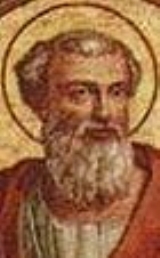
Pope Pontian
Encyclopedia
Pope Pontian or Pontianus was Pope
from 21 July 230 to 29 September 235.
A little more is known of Pontian than his predecessors, apparently from a lost papal chronicle that was available to the compiler of the Liberian Catalogue
of bishops of Rome, made in the fourth century.
During his pontificate the schism of Hippolytus of Rome came to an end. Pontian and other church leaders (among them Hippolytus) were exiled by the emperor Maximinus Thrax
to Sardinia
, and in consequence of this sentence he resigned on 25 or 28 September 235. It is unknown how long he lived in exile: according to Liber Pontificalis
he died due to the inhuman treatment and hardships he received in the Sardinian mines. According to tradition, he died on the island of Tavolara.
His feast day was 19 November, but he is now celebrated jointly with Hippolytus on 13 August.
His remains were brought to Rome by Pope Fabian
and buried in the Catacomb of Pope Callixtus I
. His epitaph was rediscovered in 1909 in the Catacomb of Callixtus
, near the papal crypt, reading "PONTIANOS, EPISK.". The inscription "MARTUR" had been added in another hand.
Pope
The Pope is the Bishop of Rome, a position that makes him the leader of the worldwide Catholic Church . In the Catholic Church, the Pope is regarded as the successor of Saint Peter, the Apostle...
from 21 July 230 to 29 September 235.
A little more is known of Pontian than his predecessors, apparently from a lost papal chronicle that was available to the compiler of the Liberian Catalogue
Liberian Catalogue
In compiling the history of the Early Christian Church, the Liberian Catalogue , which was part of the illuminated manuscript known as the Chronography of 354, is an essential document, for it consists of a list of the popes, designated bishops of Rome, ending with Pope Liberius , hence its name...
of bishops of Rome, made in the fourth century.
During his pontificate the schism of Hippolytus of Rome came to an end. Pontian and other church leaders (among them Hippolytus) were exiled by the emperor Maximinus Thrax
Maximinus Thrax
Maximinus Thrax , also known as Maximinus I, was Roman Emperor from 235 to 238.Maximinus is described by several ancient sources, though none are contemporary except Herodian's Roman History. Maximinus was the first emperor never to set foot in Rome...
to Sardinia
Sardinia
Sardinia is the second-largest island in the Mediterranean Sea . It is an autonomous region of Italy, and the nearest land masses are the French island of Corsica, the Italian Peninsula, Sicily, Tunisia and the Spanish Balearic Islands.The name Sardinia is from the pre-Roman noun *sard[],...
, and in consequence of this sentence he resigned on 25 or 28 September 235. It is unknown how long he lived in exile: according to Liber Pontificalis
Liber Pontificalis
The Liber Pontificalis is a book of biographies of popes from Saint Peter until the 15th century. The original publication of the Liber Pontificalis stopped with Pope Adrian II or Pope Stephen V , but it was later supplemented in a different style until Pope Eugene IV and then Pope Pius II...
he died due to the inhuman treatment and hardships he received in the Sardinian mines. According to tradition, he died on the island of Tavolara.
His feast day was 19 November, but he is now celebrated jointly with Hippolytus on 13 August.
His remains were brought to Rome by Pope Fabian
Pope Fabian
Pope Fabian was Pope from January 10, 236 to January 20, 250, succeeding Pope Anterus.Eusebius of Caesarea relates how the Christians, having assembled in Rome to elect a new bishop, saw a dove alight upon the head of Fabian, a layman and stranger to the city, who was thus marked out for this...
and buried in the Catacomb of Pope Callixtus I
Pope Callixtus I
Pope Saint Callixtus I or Callistus I was pope from about 217 to about 222, during the reigns of the Roman Emperors Elagabalus and Alexander Severus...
. His epitaph was rediscovered in 1909 in the Catacomb of Callixtus
Catacomb of Callixtus
The Catacomb of Callixtus was one of the Catacombs of Rome on the Appian Way, most notable for containing the Crypt of the Popes , which contained the tombs of several popes from the 2nd to 4th centuries...
, near the papal crypt, reading "PONTIANOS, EPISK.". The inscription "MARTUR" had been added in another hand.

